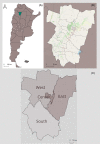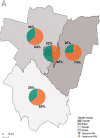Magnitude and spatial distribution of food and nutrition security during the COVID-19 pandemic in Tucumán (Argentina)
- PMID: 34174008
- PMCID: PMC8420521
- DOI: 10.1002/ajhb.23632
Magnitude and spatial distribution of food and nutrition security during the COVID-19 pandemic in Tucumán (Argentina)
Abstract
Objective: To describe the magnitude and spatial distribution of household food and nutrition security (FNS) during the COVID-19 pandemic in Tucumán (Argentina) and identify factors associated with food insecurity.
Methods: During April and May 2020 a cross-sectional quantitative study was performed. Data from 3915 households were analyzed. The study of FNS was performed with the Latin American and Caribbean Scale for Food Security. To identify associated factors, bivariate and multivariate logistic regression models were applied.
Results: Household food insecurity affected 55.9% of the sample (mild: 39.3%, moderate: 10.8%, severe: 5.8%). Analyzing the spatial distribution, the eastern area showed the highest food insecurity prevalence, followed by the south and west areas. Logistic regression analysis showed that household food insecurity varied according to household size, presence of children, socioeconomic status, and health area of residence.
Conclusions: Household size, presence of children, socioeconomic status and public health area of residence were associated to household food insecurity. The perception of hunger was higher in larger households, in those with low and medium socioeconomic status and in households located in the southern area of the province.
© 2021 Wiley Periodicals LLC.
Figures



References
-
- Ahn, S. , & Norwood, F. (2020). Measuring food insecurity during the COVID‐19 pandemic. Applied Economic Perspectives and Policy, 43(1), 162–168.
-
- Bolsi, A. , & Paolasso, P. (2009). La pobreza entre los argentinos del Norte Grande Argentino. Ciencia Hoy, 19, 8–17.
-
- Bonfiglio, J. , Salvia, A. , & Vera, J. (2020). Empobrecimiento y desigualdades sociales en tiempos de pandemia. Informe de Avance. Pontificia Universidad Católica Argentina. Observatorio de la Deuda Social Argentina.
-
- Bonfiglio, J. , Vera, J. , & Salvia, A. (2019). Pobreza monetaria y vulnerabilidad de derechos. Inequidades de las condiciones materiales de vida en los hogares de la Argentina urbana (2010–2018). Educa.
Publication types
MeSH terms
Grants and funding
LinkOut - more resources
Full Text Sources
Medical
Miscellaneous

